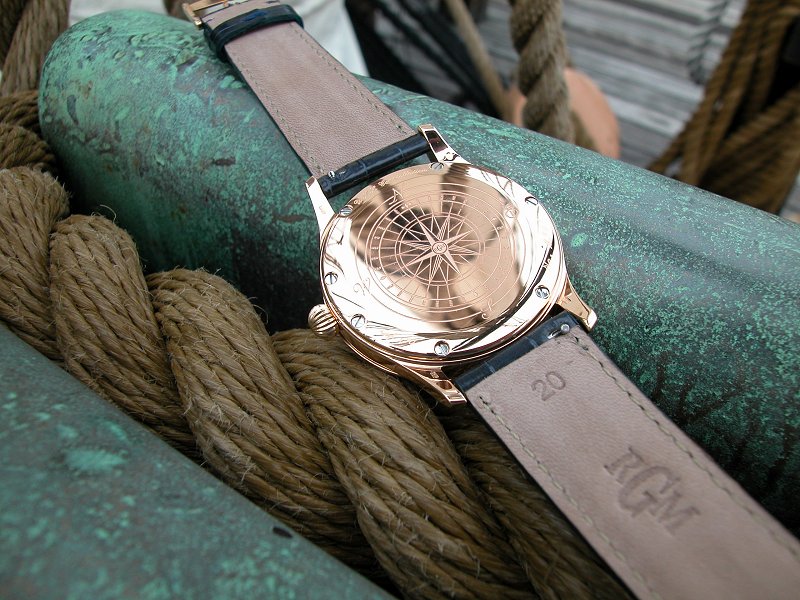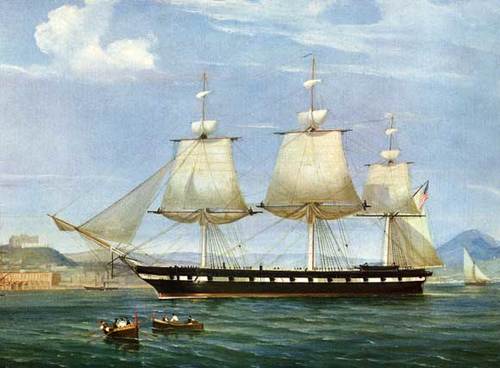RGM Watches
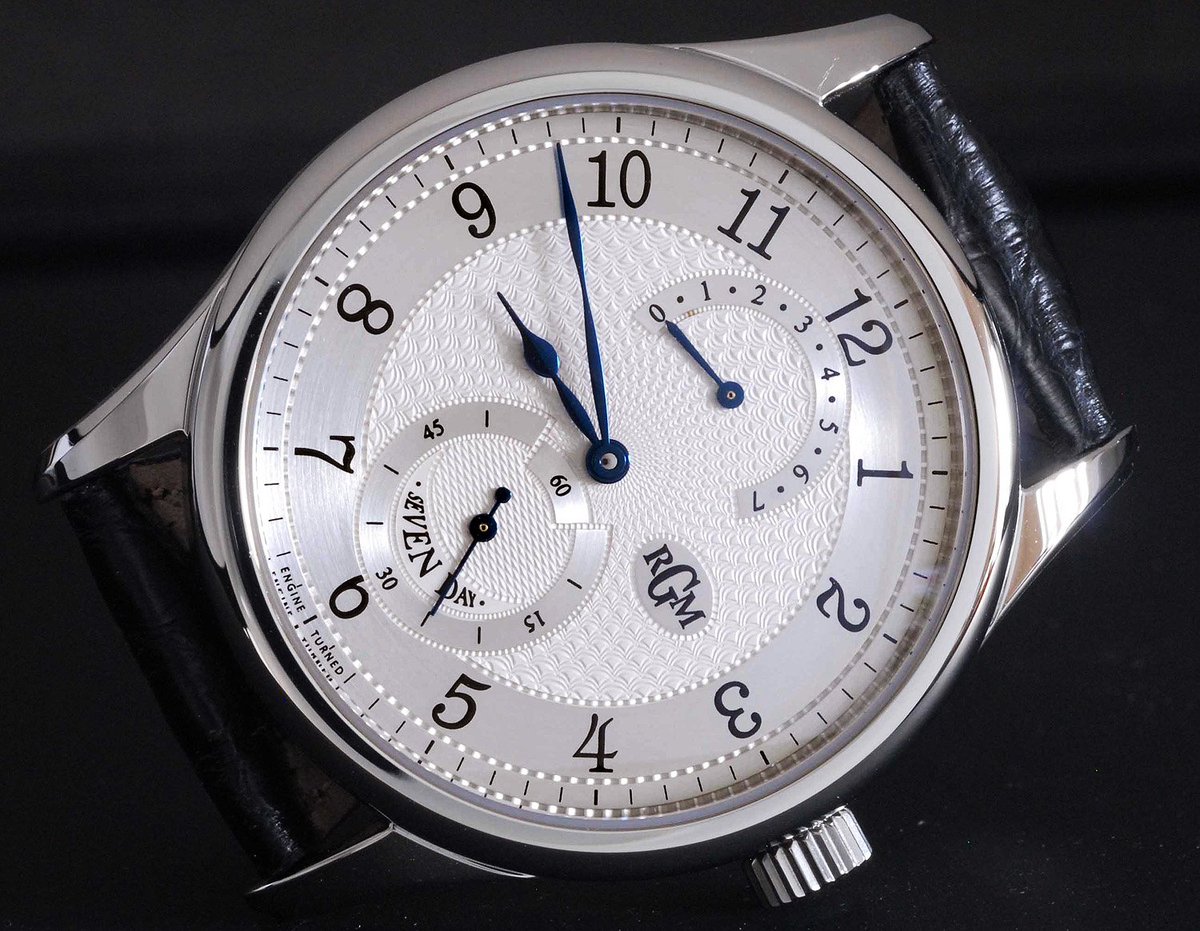
One Week at a Time
Introducing the RGM Seven Day Watch, Ref. 130
by C. Bradley Jacobs
Originally published in International Watch
November 2006
RGM Watch Company, the Lancaster County, Pennsylvania-based maker of fine timepieces announces the introduction of their first long-running wristwatch: the limited-edition reference 130 "Seven Day." The clean lines of the case--42 mm in stainless steel with sapphire crystals front and back--are the perfect complement for the dynamic dial. This original design combines bold numerals, sleek blue hands and elegant guilloché. The long-running nature of the movement is indicated on the dial via a 7-day  power reserve index at 12 o'clock; contributing to its balance is a small seconds indicator at 6 o'clock. A large central field of hand-turned guilloché adds a sense of both motion and serenity to an overall package that is detailed and yet very easily readable.
power reserve index at 12 o'clock; contributing to its balance is a small seconds indicator at 6 o'clock. A large central field of hand-turned guilloché adds a sense of both motion and serenity to an overall package that is detailed and yet very easily readable.
The power for RGM Ref. 130 comes from a new addition to the RGM line. The modified RGM/Jaquet movement features high-quality hairspring, mainspring, escapement and balance with precision regulator. The plates are decorated with perlage while the bridges are tastefully adorned with côtes de Genève and blued screws. Twin mainspring barrels and 19 jewels help ensure that the movement, which is adjusted to five positions, runs smoothly through its 7-day power reserve. Just a glance through the caseback window reveals to the aficionado of luxury timepieces that this is a fine  movement of a type that is not commonly seen on the market. The layout of the winding train and the gear train, both efficiently engineered into a reasonably sized package, will be a welcome change to those unused to complicated hand-wound movements or watches with such a long reserve of power. The familiar threaded case back and movement logo of RGM ensure that quality is guaranteed as much as exclusivity.
movement of a type that is not commonly seen on the market. The layout of the winding train and the gear train, both efficiently engineered into a reasonably sized package, will be a welcome change to those unused to complicated hand-wound movements or watches with such a long reserve of power. The familiar threaded case back and movement logo of RGM ensure that quality is guaranteed as much as exclusivity.
The Seven Day watch is available in a limited series of only thirty pieces. Each example boasts a polished steel case with brushed sides, fine exotic leather straps, a signed steel deployant clasp, and RGM carrying case and box. MSRP for this fine long-player is $7900. As with all RGM watches, custom orders are welcome.
Founded by master watchmaker Roland G. Murphy, RGM Watch Company is located in the heart of one of America's premier historic watchmaking centers. An independent firm, RGM produces fine watches including a minute repeater with tourbillon, the William Penn collection of elegant rectangular watches, a series of steel pilots' models, and special editions utilizing the nearly lost arts of engraving and engine-turning. Mr. Murphy's company is one of a select number who will modify examples of their existing product line or endeavor to make a totally exclusive, unique, high-grade timepiece at the request of the customer. More information can be found at RGMWatches.com or by calling (717) 653-9799.

RGM Ref. 170
USS Constellation Commemorative
by C. Bradley Jacobs
Originally published in International Wristwatch
January 2004RGM Introduces a New Limited Edition Timepiece
to Commemorate the USS Constellation
What could a 19th century sailing vessel and a 21st century watchmaker possibly have in common? For starters, each represents technology considered obsolete to most but revered by many others. Secondly, each can claim a connection to Baltimore, MD which is the birthplace of Roland G. Murphy and is where the USS Constellation, the US Navy's last all-sail warship, has been moored for the last 48 years. Lastly, a new RGM timepiece will be helping celebrate the Constellation's 150th birthday in the coming months.
2004 marks 150 years since the launching of the venerable ship in 1854. Once being placed in commission by the US Navy (28 July 1855), this stately vessel served various roles, from squadron flagship to training vessel, for an entire century before being restored and installed in Baltimore as a monument to America's great naval heritage.
To celebrate the history of the Constellation, and to express his admiration for fine sailing vessels, RGM Watch Company of Lancaster, PA is preparing to issue the first in a series of limited-edition wristwatches, each bearing the likeness of a great ship. Featuring an original relief engraving of the Constellation on the silver dial, the first model (RGM ref. 170) will have an automatic movement in an elegant 18k rose gold case and will be offered as a limited edition of just 25 pieces.
Mr. Murphy and RGM's chief of design, Rich Baugh, both share a passion for fine timepieces and for things nautical. Mr. Baugh is a native of Delaware and grew up surrounded by reminders of that state's contributions to and reliance upon maritime commerce. As a result, his interest in sailing is strong and is a source of inspiration for projects such as designing the dial and caseback of the USS Constellation watch.
Not content simply to borrow the likeness of the ship for use on their watch Messrs. Murphy and Baugh recently completed a trip to the Inner Harbor in Baltimore to help give back to the ship that has inspired them. Their visit, a sort of pilgrimage really, was timed to coincide with an auction held aboard the Constellation on September 4, 2003. Various examples of nautical art were offered at the first (and expected to be annual) Constellation Art Auction & Reception held aboard the ship. Featured in the auction was an original pen-and-ink drawing by Mr. Baugh, which was the first of a pair of drawings used to determine the final design of the aforementioned wristwatch dial. The framed artwork depicts the ship, with her sails deployed, plying a calm evening sea. A similar image adorns the RGM watch, although the details of the side of the vessel are clearer on the dial than on paper, a fact attributable as much to the precision of the dial maker as to the more artistic nature of the framed drawing.
Mr. Murphy plans to create subsequent series commemorating other great sailing ships. Understanding that each ship represents the hard work of designers, builders and crew, the RGM team plans to make each commemorative edition substantially different from the others. Where the Constellation watch features a side view of the ship, another watch in the series is expected to portray the English ship HMS Victory (the oldest commissioned warship in the world which was also Admiral Nelson's flagship at the Battle of Trafalgar) from the stern as the ship sails away from view. Another watch is expected to display a dynamic image of the bow of a ship cutting through the waves. So that this series of watches will further stand out from the crowd, RGM is considering the use of engraved case sides and etched-glass casebacks on some future models. Suffice it to say, each watch, like the ship it represents, will have a strong and unique personality.
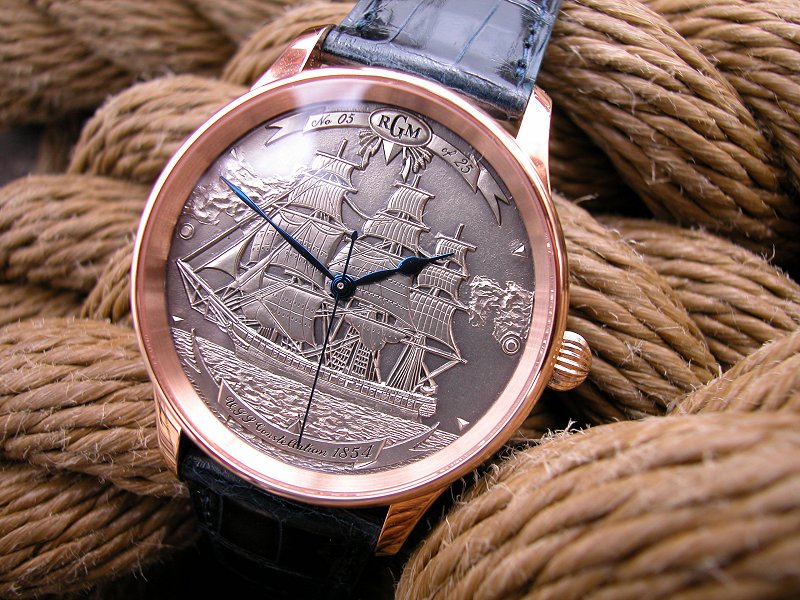
For more information on RGM watches, contact the company at 717-653-9799 or visit www.rgmwatches.com.To learn more about the USS Constellation and the upcoming 150th anniversary celebrations, visit www.constellation.org/150.html, call 410-539-1797, or visit the ship at Pier 1, 301 East Pratt Street, in the Inner Harbor of Baltimore, Maryland.
~~
~
~

Photo above courtesy Phil StoverText © C. Bradley Jacobs, WatchCarefully.com; photos provided by RGM unless otherwise indicated

RGM 222-RR ↔ A WatchCarefully Review
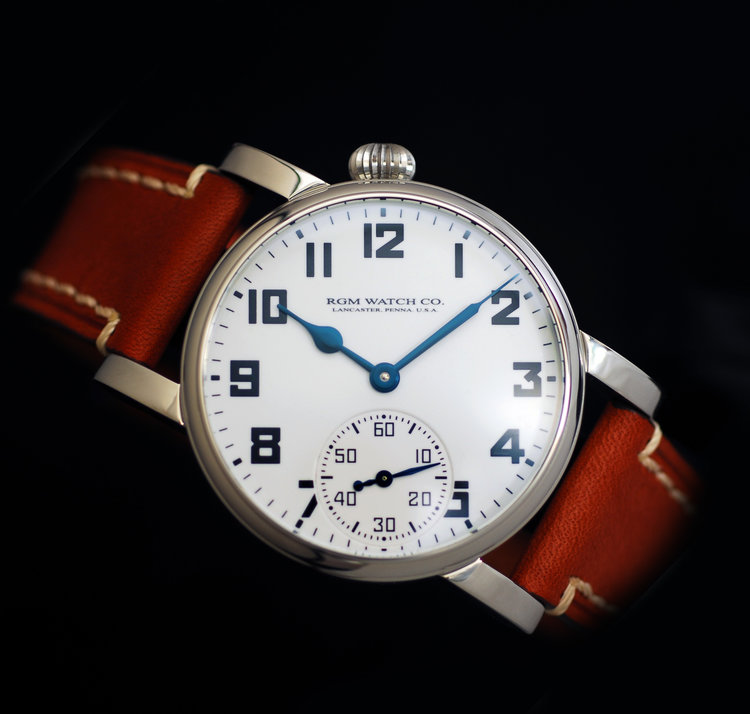
C. Bradley Jacobs
Nov 2018
Some photos provided by RGM Watch Co.
In 2017, the RGM Watch Company celebrated 25 years in existence with a party at the NAWCC Watch & Clock Museum and the release of some special timepieces. Earlier in his career, the founder of the company, Roland G. Murphy, had worked as Technical Manager for Hamilton in Lancaster, Pennsylvania when he began independently producing small series of Swiss movement-powered watches from his home in 1992. A quarter-century later, RGM can be found operating from an old bank building in nearby Mt. Joy (image below), where a staff of experienced watchmakers and designers now produce watch movements in-house, apply hand-turned guilloché, and even use locally-made cases, boxes and other accessories. They are internationally renowned as America’s finest producer of wristwatches and for keeping many elements of traditional craftsmanship alive. Though some of their movements and parts are still provided by European manufacturers, they are best known for their in-house productions: Caliber 801, a large round movement evocative of the finest American-made pocketwatch movements, Caliber 20, a tonneau-shaped complicated movement introduced for the 20th anniversary of the brand, and the only tourbillon wristwatch ever serially produced in the USA: the Pennsylvania Tourbillon.
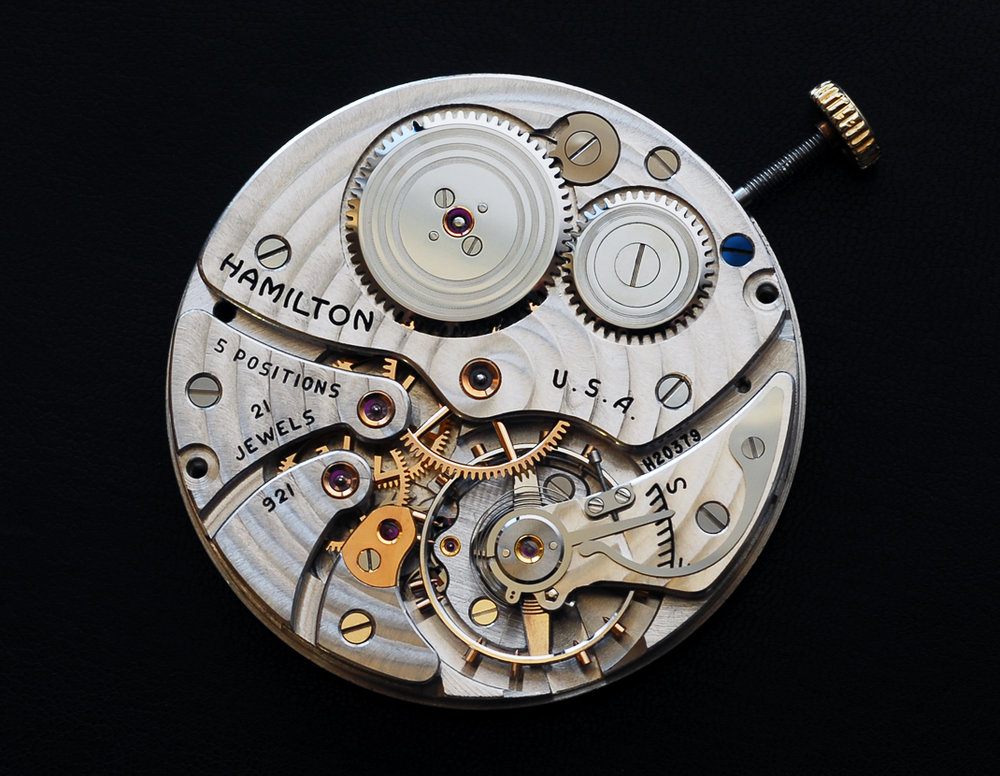
Alongside the modern marvels they produce, and their devotion to reviving the lost arts of American watchmaking, RGM has also made a name for themselves with their Reference 222 (Roland G. Murphy Signature Series) which almost single-handedly spawned a trend for re-purposing smaller US-made pocketwatch movements of high grade into wristwatches. So it is fitting that they have chosen to issue a revision of the 222 that celebrates another icon of American horology: the Railroad Watch.
Christened with reference 222-RR, the new piece utilizes the same basic case as the original 222 (introduced ca. 2005) and is driven by a vintage Hamilton 10-size movement—either Grade 921 or Grade 923, all produced down the road in Lancaster, PA between 1937 and the mid-1950s. RGM no longer offers the lower-grade 917 or 945, choosing instead to focus on the most heavily refined and technologically advanced of the 4 movements in that family.
There are two significant and obvious differences between the earlier 222s and the new 222-RR; whereas the 222 used the open-face Hamilton calibers in a “side-winder” format (the crown at 3 and the sub-dial at 9:00) the new 222-RR keeps the crown at the 12:00 dial position, but both the crown and 12:00 are canted a bit clockwise, just to the right of the upper strap lugs. The second difference is the stunning enamel dial, reminiscent of those first used on railroad watches in the mid-1920s.
The 222-RR features a dial of true fired enamel, also known as ‘grand feu,’ whose bold block numerals recreate the style of railroad pocketwatches often called Boxcar Dials. As early as the 1890s, railroad workers were required to possess watches of certified accuracy and clear readability, intended to deter the possibility of train collisions. A departure from the style of early RR watches, Elgin and other major American firms began to offer the thick, utilitarian numerals seen here beginning in 1924.
 The connection of this watch to those of the early inter-war years is also reflected in the aforementioned positioning of the crown. During World War I, the benefits of a wristwatch (over a pocketwatch) became evident to servicemen in action. This prompted a surge in production of watches for the wrist among American companies whose watches typically focused on pocket watches for men and considered ‘wristlet’ watches a novelty or jewelry item, mainly suitable for women. As a result, the watch producers found themselves using the movements of womens’ pendant watches as the basis for wristwatches for men. This was a simple transition for hunter-style movements (crown at 3:00, seconds at 6:00) but meant that using open-face movements for the wrist would require the printing of new dials…or make some simple adjustments. Thus, there came into existence examples of ‘transitional’ wristwatches whose configuration is reflected in today’s RGM 222-RR.
The connection of this watch to those of the early inter-war years is also reflected in the aforementioned positioning of the crown. During World War I, the benefits of a wristwatch (over a pocketwatch) became evident to servicemen in action. This prompted a surge in production of watches for the wrist among American companies whose watches typically focused on pocket watches for men and considered ‘wristlet’ watches a novelty or jewelry item, mainly suitable for women. As a result, the watch producers found themselves using the movements of womens’ pendant watches as the basis for wristwatches for men. This was a simple transition for hunter-style movements (crown at 3:00, seconds at 6:00) but meant that using open-face movements for the wrist would require the printing of new dials…or make some simple adjustments. Thus, there came into existence examples of ‘transitional’ wristwatches whose configuration is reflected in today’s RGM 222-RR.
All 222-RR enamel dials are white with black numerals, and they employ a unique set of hands created especially for this model.  They are blued steel in the traditional railroad shape, but their aesthetically pleasing proportions are specific to this watch. The example 222-RR shown here is motivated by a Hamilton Grade 923, made in 1946. Although Railroad specifications through the 1920s-1960s required a watch of 16-size, in order to keep the 222-RR manageable for the wrist, employing a 10-size movement was necessary. Happily, the Hamilton 923 (23 jewels, fewer than 3600 produced) and its sibling Grade 921 (21 jewels, approx. 54,000 produced) were highly refined and adjusted for accuracy that helped them meet or exceed expectations of railroad accuracy. That they were built in Lancaster, PA, a short drive from RGM’s home, reinforces the noteworthiness of this watch, the first to combine such significant American watchmaking history with a modern homage to the great watches carried by railroad men of yore.
They are blued steel in the traditional railroad shape, but their aesthetically pleasing proportions are specific to this watch. The example 222-RR shown here is motivated by a Hamilton Grade 923, made in 1946. Although Railroad specifications through the 1920s-1960s required a watch of 16-size, in order to keep the 222-RR manageable for the wrist, employing a 10-size movement was necessary. Happily, the Hamilton 923 (23 jewels, fewer than 3600 produced) and its sibling Grade 921 (21 jewels, approx. 54,000 produced) were highly refined and adjusted for accuracy that helped them meet or exceed expectations of railroad accuracy. That they were built in Lancaster, PA, a short drive from RGM’s home, reinforces the noteworthiness of this watch, the first to combine such significant American watchmaking history with a modern homage to the great watches carried by railroad men of yore.

Before building any vintage Hamilton caliber into a Ref 222, a single RGM watchmaker performs restoration and improvement activities—installing a new purpose-made mainspring, polishing any discolored parts to better-then-new condition, and executing a complete overhaul and lubrication. The balance is poised, the movement is adjusted and monitored then, only after having been cased and observed for some days, it is approved for release to its new owner.
Due to the size of the classic movement RGM uses, the 222 watches measure 41.0 mm x 12.0 mm, in cases of 316L Stainless Steel. Sapphire crystals are installed front and back; water resistance is 5 ATM. RGM supplies the 222-RR on sturdy Hirsch Liberty leather straps with ample thickness, contrasting stitching and 22mm width tapering to 20mm ends. A shapely steel buckle is provided, subtly engraved with the RGM logo.
Prices for the RGM 222-RR begin at $5900 US for an example with Grade 921 movement. The price of $7900 for a watch with the Grade 923 movement reflects the extreme difficulty of obtaining (and atmospheric rise in prices asked for) Grade 923 movement and parts in the requisite exemplary condition to be considered for use in an RGM watch. Although Hamilton produced hundreds of thousands of movements in the 917/945/921/923 family, barely over 300 Grade 923s (on average) left the Hamilton factory during each year of its production.
Information on the 222-RR and all RGM products is available via the company’s website. A closer look at the Scatola del Tempo box pictured in this review is available here.

Reflections of the author:
 Having now owned this piece since the middle of 2018, and a custom-built 222-E since 2005, I’m quite comfortable with its size. It is comparable to many watches powered by modern ETA 6497/6498 movements (e.g., Eberhard Traversetolo, Chronoswiss TimeMaster, Panerai, etc) and perhaps a bit more wearable than some. The 222-RR has a fairly thin bezel, so the 41mm case admirably manages to act as a subtle showcase for about 37 millimetres of dial. As the dial is true enamel, with the reflectiveness and amazing contrast typical of that material, the case and bezel would be easy to ignore, but for the substantial size of the lugs (which, frankly, I would prefer to be less obtrusive).
Having now owned this piece since the middle of 2018, and a custom-built 222-E since 2005, I’m quite comfortable with its size. It is comparable to many watches powered by modern ETA 6497/6498 movements (e.g., Eberhard Traversetolo, Chronoswiss TimeMaster, Panerai, etc) and perhaps a bit more wearable than some. The 222-RR has a fairly thin bezel, so the 41mm case admirably manages to act as a subtle showcase for about 37 millimetres of dial. As the dial is true enamel, with the reflectiveness and amazing contrast typical of that material, the case and bezel would be easy to ignore, but for the substantial size of the lugs (which, frankly, I would prefer to be less obtrusive).
The fantastic dial is accentuated by the unusual angle at which it is displayed—the overall effect has retained its novelty for months now—and I find myself drawn to admire this watch as often as to tell the time.
As with all RGM watches, the quality of their production (and of the components provided by their external suppliers) is top-notch, so there are no distractions or complaints here. Any inadvertent oversights in their quality department are quickly rectified—this I know through personal experience. But more significant to me is that every element of this watch is harmonious. The lustre of the dial, the depth of the sunken seconds register, the hue and shape of the hands, the weight of all the printed elements, the color of the straps, the design itself—everything combines to give the wearer the impression of having a true railroad watch for the wrist.
The rear view of the watch does just what it should. It simply and directly (again, a thin bezel is key here) provides one a window into another time. Although RGM has made subtle improvements to the movement within, it remains an example of the highest-quality American made movement of its class and, though not a true RR-grade watch (as described above) it is surely the most apt substitute, whether in 23- or 21-jewel form. The 222-RR looks and feels like a little piece of 20th-century history for the wrist and I consider it to be another significant accomplishment by RGM in their quest to represent and maintain the high horological standards of American watchmaking.
© C. Bradley Jacobs, WatchCarefully.com



